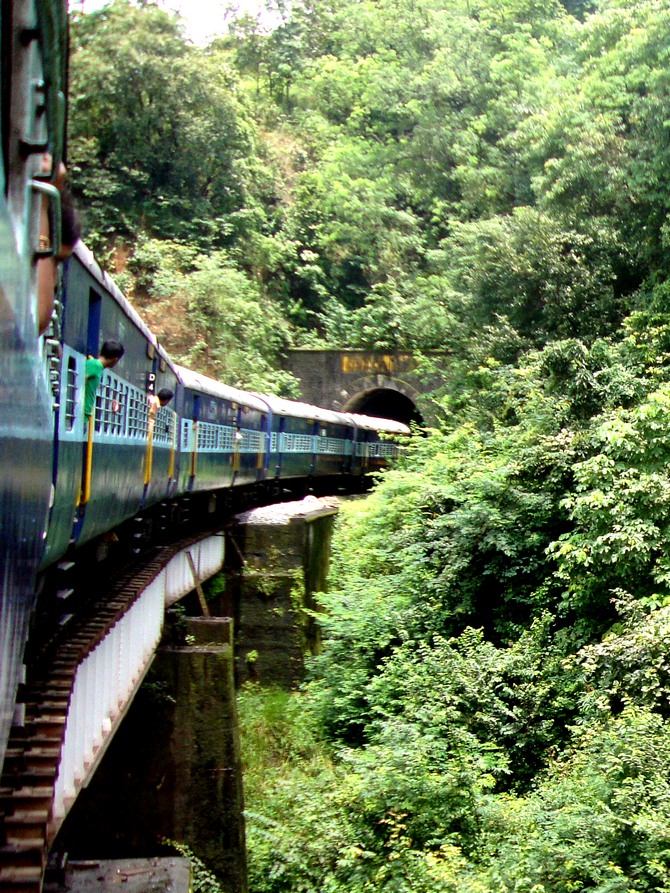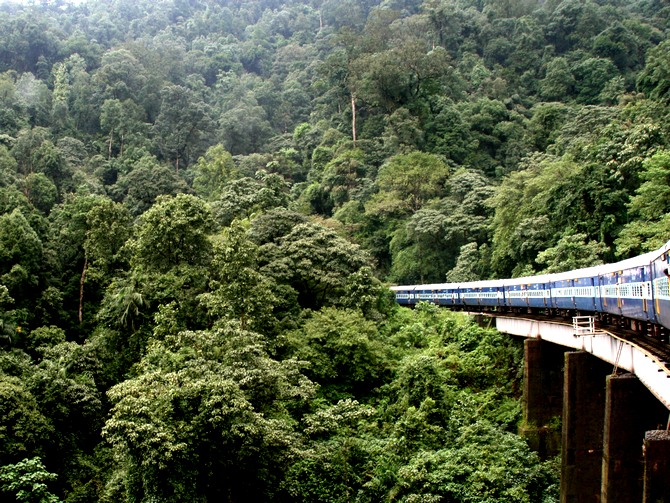
If the Western Ghats aren't magical enough already, they take a new life altogether during the monsoons. Anita Rao Kashi travelled through them in possibly the best mode of transport -- the railway.
The sky was overcast, being the height of monsoons; a light drizzle came on and off and the overall mood was one of gloominess. But I was excited and the overcast sky and rain tied in neatly with what I was expecting as I headed to Mangalore railway station for a trip through the Western Ghats on the Karwar-Yeshwantpur (Bangalore) express, which plies via Mangalore.
The train was already on the platform and I hastened to find my seat. There was the usual noise and bustle that accompanies a train but I was immune to it and concentrated on what I was likely to encounter.
Though the journey from Mangalore to Bangalore, a distance of just over 350 km takes 11 hours, my focus was on the two-hour, 58 km stretch during which the train passes through the magnificent Western Ghats.
It was this bit that made the journey precious. I had heard that it went through 58 tunnels, 109 bridges and 25 waterfalls, providing glimpses of breathtaking scenery and making it one of the most memorable train journeys in the country. I was fascinated by the descriptions I had heard and wanted to experience it first-hand.
Around me was a motley mix of passengers who seemed content to keep to themselves, which was fine by me. As I settled in my seat, the train chugged out of the station and my journey had begun. For the first two hours, nothing much happened as the train passed through plains and sundry towns and villages. The clackety-clack rhythm of the train was soothing and relaxed me, along with the fresh morning breeze blow against my face. The train stopped and started at a handful of stations, but they all passed in a blur.

Nearly two hours after I had started, it stopped at Subramanya Road, and I knew the best part was about to begin. Soon the train gently made its way of the station and a few minutes later the bright morning light streaming in from the windows was suddenly cut off as the train entered a tunnel and everything became pitch dark. The sudden darkness was disorienting but the train emerged from out of the tunnel and my breath was jerked out of me due to the sheer gorgeousness of what I found outside the window.
It had started to rain in earnest, blanketing everything in a fine mist, while a gushing stream, jumping and dancing over rocks and boulders, passed under the train. It was fringed by thick vegetation, everything glistening with the falling rain. Add to it the thud-thudding of the train and whole scene became rather riveting. I was spellbound.
I struggled to take everything in sight even as the train wrapped itself around a craggy hill, shining with dripping water and hit the next tunnel.
When the tunnel ended, another spectacular scene awaited: the exit was flanked by a roaring waterfall and water gushed into the train from the windows, even as the train began a slow ascent over a huge curving bridge across a river full of rushing muddy water which lay at least a few hundred feet below.
The river was obviously swollen from the steady monsoon rains and seemed ready to burst its banks but appeared to be held back by the thick forests which lined it on either side. I stared at this scene that was way below me and for a moment the train seemed precariously suspended over this scene.
For a moment I felt like I was inside a movie, looking down from a camera up in the sky. I was enthralled, my camera forgotten for the moment, as my eyes took precedence. And this became constant leitmotif for the two-hour stretch.
About 30 minutes after entering the first tunnel, the train crossed Shiribagilu station, one of the stops on the Green Route or Railway Track Trek (a two day, 30 km trek popular with hardcore trekkers, but needs to be done with utmost caution) and hit the next tunnel. The scene changed a bit from here and the scene spread out, providing stunning vistas and panoramic views.

The train hugged a rocky mountain on one side, but on the other, the ground seemed to have just fallen away while a large part of the Western Ghats lay spread out before me. In the distance were towering peaks covered with deep green forests, topped by velvety green grass and crowned by with wispy clouds.
In-between lay valleys, packed with more thick forests, and broken occasionally by waterfalls which looked like foamy white ribbons. A sweeping curtain of mist, which dropped and lifted whimsically, made the scene even more magical and mystical.
The scene changed constantly, interrupted only by moments of pitch blackness when we passed through tunnels. When we arrived at Yadakumari station, almost the halfway mark in the stretch, it was nearly blanketed with mist while a fine drizzle was falling gently. Some of the buildings were covered almost entirely by moss, making the whole scene rather surreal. As the train continued its onward journey, the fleeting montage of nature's scenes continued to repeat over and over again, and yet it never got boring or felt repetitive even for a second.
About two hours after the train had entered the first tunnel, when the surrounding area seemed to level off, indicating that the train was descending into the plains, I felt bereft.
Coffee plantations came into view, quickly followed by paddy fields and sundry crops, and even though this was lovely in its own way, it just couldn't compare to the wild beauty of the Western Ghats that I had just witnessed.
Soon, the train chugged into Sakleshpur, and I realised that the interesting part of the journey was over. Given a chance I would have loved to reverse gear and head back for a second look at what I had just gone through. But alas, I was not in charge of the train and had to content myself with the images I had just passed, which began a steady stream in my head.
Fact file
Yeshwantpur (Bangalore)-Karwar express (via Mangalore) plies both ways on alternate days, though the trip is better done from Mangalore.
When to go: To experience the glory of the Western Ghats, go either during the monsoons or just after. However, do check as the train is sometimes cancelled during exceptionally heavy rains for fear of landslides.